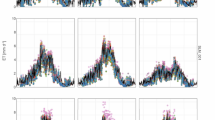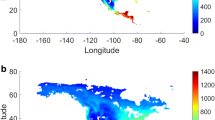Abstract
arising from S. Jasechko et al. Nature 496, 347–350 (2013)
How best to assess the respective importance of plant transpiration over evaporation from open waters, soils and short-term storage such as tree canopies and understories (interception) has long been debated. On the basis of data from lake catchments, Jasechko et al.1 conclude that transpiration accounts for 80–90% of total land evaporation globally (Fig. 1a). However, another choice of input data, together with more conservative accounting of the related uncertainties, reduces and widens the transpiration ratio estimation to 35–80%. Hence, climate models do not necessarily conflict with observations, but more measurements on the catchment scale are needed to reduce the uncertainty range. There is a Reply to this Brief Communications Arising by Jasechko, S. et al. Nature 506, http://dx.doi.org/10.1038/nature12926 (2014).

a–c, Box plots are calculated using a simplified Monte Carlo simulation of equation (4)1 with data from Jasechko et al .1 (a), and with the same data as in a but with Q = 39,600 ± 5,100 km3 per year and xP = 20,100 ± 9,800 km3 per year (b), and with the same data as in b but with dE = 75 ± 60‰ (c). The blue box indicates the 25th and 75th percentiles with the median in red. The error bars indicate the minimum and maximum values. The red crosses indicate outliers (3/2 times the central box).
Similar content being viewed by others
References
Jasechko, S. et al. Terrestrial water fluxes dominated by transpiration. Nature 496, 347–350 (2013)
Oki, T. & Kanae, S. Global hydrological cycles and world water resources. Science 313, 1068–1072 (2006)
Dai, A. & Trenberth, K. E. Estimates of freshwater discharge from continents: latitudinal and seasonal variations. J. Hydrometeorol. 3, 660–687 (2002)
Syed, T. H., Famiglietti, J. S., Chambers, D. P., Willis, J. K. & Hilburn, K. Satellite-based global-ocean mass balance estimates of interannual variability and emerging trends in continental freshwater discharge. Proc. Natl Acad. Sci. USA 107, 17916–17921 (2010)
Wang, D., Wang, G. & Anagnostou, E. N. Evaluation of canopy interception schemes in land surface models. J. Hydrol. 347, 308–318 (2007)
Dirmeyer, P. A. et al. GSWP-2: multimodel analysis and implications for our perception of the land surface. Bull. Am. Meteorol. Soc. 87, 1381–1397 (2006)
Miralles, D. G., Gash, J. H., Holmes, T. R. H., de Jeu, R. A. M. & Dolman, A. J. Global canopy interception from satellite observations. J. Geophys. Res. 115, 27 (2010)
Gerrits, A. M. J., Pfister, L. & Savenije, H. H. G. Spatial and temporal variability of canopy and forest floor interception in a beech forest. Hydrol. Processes 24, 3011–3025 (2010)
Brooks, J. R., Barnard, H. R., Coulombe, R. & McDonnell, J. J. Ecohydrologic separation of water between trees and streams in a Mediterranean climate. Nature Geosci. 3, 100–104 (2010)
Hrachowitz, M., Savenije, H., Bogaard, T. A., Tetzlaff, D. & Soulsby, C. What can flux tracking teach us about water age distribution patterns and their temporal dynamics? Hydrol. Earth Syst. Sci. 17, 533–564 (2013)
Kendall, C. & McDonnell, J. J. Isotope Tracers in Catchment Hydrology (Elsevier, 1998)
Keenan, T. F. et al. Increase in forest water-use efficiency as atmospheric carbon dioxide concentrations rise. Nature 499, 324–327 (2013)
Yuan, W. et al. Global estimates of evapotranspiration and gross primary production based on MODIS and global meteorology data. Remote Sens. Environ. 114, 1416–1431 (2010)
Welp, L. R. et al. Interannual variability in the oxygen isotopes of atmospheric CO2 driven by El Niño. Nature 477, 579–582 (2011)
Zhang, S., Wen, X., Wang, J., Yu, G. & Sun, X. The use of stable isotopes to partition evapotranspiration fluxes into evaporation and transpiration. Acta Ecol. Sin. 30, 201–209 (2010)
Author information
Authors and Affiliations
Contributions
All authors contributed equally, and all authors contributed to the data analysis.
Corresponding author
Ethics declarations
Competing interests
Competing Financial Interests Declared none.
PowerPoint slides
Rights and permissions
About this article
Cite this article
Coenders-Gerrits, A., van der Ent, R., Bogaard, T. et al. Uncertainties in transpiration estimates. Nature 506, E1–E2 (2014). https://doi.org/10.1038/nature12925
Published:
Issue Date:
DOI: https://doi.org/10.1038/nature12925
- Springer Nature Limited
This article is cited by
-
Evapotranspiration on a greening Earth
Nature Reviews Earth & Environment (2023)
-
A planetary boundary for green water
Nature Reviews Earth & Environment (2022)
-
Recent global decline in rainfall interception loss due to altered rainfall regimes
Nature Communications (2022)
-
The residence time of water vapour in the atmosphere
Nature Reviews Earth & Environment (2021)
-
Soil-plant-atmosphere interactions: structure, function, and predictive scaling for climate change mitigation
Plant and Soil (2021)





